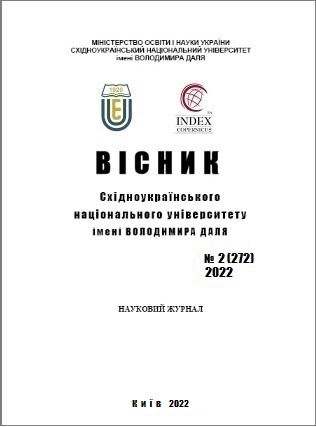Дослідження впливу локальної поверхневої лазерної обробки на структуру швидкорізальних та штампових сталей
DOI:
https://doi.org/10.33216/1998-7927-2022-272-2-110-115Ключові слова:
швидкорізальні сталі, інструментальні штампові сталі, мікротвердість, зносостійкість, лазерна обробкаАнотація
У статті досліджено вплив параметрів режиму локальної поверхневої лазерної обробки на структуру швидкорізальних та інструментальних сталей. Для оцінювання можливості поверхневого оплавлення інструменту при його лазерному гартуванні запропоновано використовувати комплексний параметр режиму лазерної обробки – критичну щільність потужності лазерного випромінювання. Щільність потужності лазерного випромінювання є комплексним параметром режиму обробки, який пов’язує між собою діаметр лазерного променя, його потужність та швидкість переміщення лазерного променя відносно оброблюваного виробу. Встановлено оптимальні значення щільності потужності лазерного випромінювання, при якій попереджається поверхневе оплавлення оброблюваних матеріалів та водночас досягається максимальна мікротвердість поверхневого зміцненого шару. Експериментально доведено, що саме високотемпературне гартування з твердого стану дає можливість отримати максимальну мікротвердість та дисперсність структури загартованого шару. Обробка з оплавленням поверхні є небажаною внаслідок різкого зменшення мікротвердості загартованого шару через утворення значної кількості залишкового аустеніту. Встановлено, що глибина зміцненого шару залежить від вихідної мікроструктури оброблюваних матеріалів. Максимальна глибина зміцненого шару досягається у тому випадку, коли перед лазерним опромінюванням інструментальні швидкорізальні та штампові сталі піддаються об’ємному гартуванню та відпуску за типовими режимами. Встановлено, що основною причиною збільшення глибини зміцненого шару у цьому випадку є менша теплопровідність загартованих сталей у порівнянні із сталями, що знаходяться у рівноважному стані. Визначено оптимальні значення коефіцієнта перекриття лазерних доріжок, при якому досягається мінімальна ширина зон відпуску.
Посилання
1. Дубняков В.Н., Ковалев А.И., Кащук О.Л. Роль мартен-ситного превращения в упрочнении стали при лазерной обработке и последующей деформации // МиТОМ, 2008. № 9. С. 54 – 57.
2. Забелин А.М.Лазерные технологии в машиностроении / А.М. Забелин, А.М. Оришин, А.М. Чирков. – Новоси-бирск: Изд-во Новосибирского гос. тех. ун-та, 2014. – 142с.
3. Гуреев Г.Д.Влияние лазерной и лазерно-ультразвуковой обработок на изменение износостойкости поверхностей трения стали // Вестник Самар. гос. техн. ун-та. Сер.: Физ.-мат. науки, 2017. № 2. С. 138 – 144.
4. Кремнев Л.С.Упрочнение рабочих поверхностей плос-копараллельных концевых мер длины лазерным излу-чением // ФиХОМ, 2020. № 3. С. 13 – 16.
5. Веденов А.А.Физические процессы при лазерной обра-ботке материалов. – М.: Машиностроение, 2019. 428с.
6. Абильсинтов Г.А.Физические основы обработки мате-риалов лучами лазера. – М.: Машиностроение, 2016. 2283с.
7. Гольдштейн М.И.Специальные стали. – М.: Металлур-гия, 1998. 408 с.

